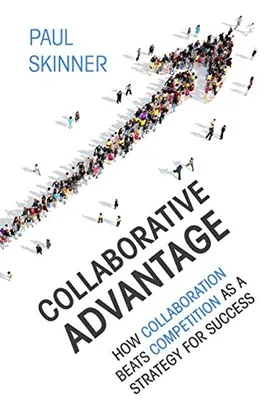Collaborative Advantage: How collaboration beats competition as a strategy for success by Paul Skinner
In his book Collaborative Advantage: How Collaboration Beats Competition as a Strategy for Success, Paul Skinner makes an argument that collaboration is a more powerful strategy for success than competition. According to Skinner, competition is outdated, relying only on brute force and luck to succeed, and collaboration offers many advantages over competition that make it more successful in the long run.
Skinner says that collaboration is the key to success in a rapidly changing and interconnected world. While competition thrives in siloed, linear organizations, collaboration enables us to break down those silos, increase communication and understanding, and use diversity of thought to create better solutions to complex issues. By collaborating, companies can tap into innovative ideas and resources that competition often misses or overlooks, leading to more successful outcomes.
Furthermore, Skinner argues that collaboration leads to increased trust, an important factor in business success. When businesses are willing to work together, trust can be built more quickly, enabling more efficient and effective partnerships. Collaboration also reinforces trust, as businesses must remain in communication, provide solutions, and build solutions in real-time. This builds credibility and strengthens relationships, further reinforcing trust and creating a strong network of allies.
Not only does collaboration lead to better outcomes and increased trust, but it also helps keep things organized. Collaboration tools and communication are essential for successful collaborations. By relying on technology like project management tools, group chat, and cloud storage, teams can work together more efficiently and stay organized. This helps promote positive relationships between team members, makes meetings and projects more productive, and eliminates waste and inefficiency associated with competition.
Finally, Skinner argues that collaboration is key to creating a sustainable competitive advantage. While competition can quickly become a race to the bottom, with companies striving to outdo each other in ever-more expensive and resource-consuming ways, collaboration encourages companies to focus on solutions that add value to their customers while also adding value to the company. By collaborating, businesses can develop and share ideas, resources, and knowledge to create long-term advantages and help everyone involved succeed.
In sum, Skinner’s book Collaborative Advantage offers a compelling argument for why collaboration should be seen as the key to success in business. While competition can offer short term results, it is often based on luck, and ultimately it only leads to more wasteful and inefficient production processes. On the other hand, collaboration offers numerous advantages, from increased trust and better outcomes, to increased efficiency and sustainability, making it the clear choice for any business looking for a long-term, successful business strategy.

